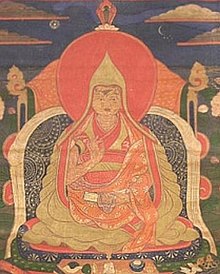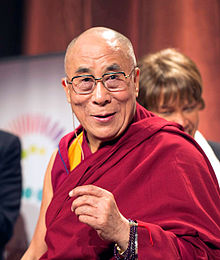Dalai Llama
| Dalai Lama | |
|---|---|

|
|
| Reign | 1391–1474 |
| Tibetan | ཏཱ་ལའི་བླ་མ་ |
| Wylie transliteration | tā la'i bla ma |
| Pronunciation | Tibetan pronunciation: [táːlɛː láma] |
| Conventional Romanisation | Dalai Lama |
| House | Dalai Lama |
| Dynasty | Gelug |
| Tenzin Gyatso | |
|---|---|
| The 14th Dalai Lama | |
 |
|
| Reign | November 17, 1950 – present |
| Predecessor | 13th Dalai Lama |
| Prime Ministers | |
| Tibetan | བསྟན་འཛིན་རྒྱ་མཚོ་ |
| Wylie | bstan 'dzin rgya mtsho |
| Pronunciation | [tɛ̃ ́tsĩ càtsʰo] |
| Transcription (PRC) |
Dainzin Gyaco |
| THDL | Tenzin Gyatso |
| Father | Choekyong Tsering |
| Mother | Diki Tsering |
| Born |
6 July 1935 Taktser, Qinghai |
| Signature |  |
Dalai Lama /ˈdɑːlaɪ ˈlɑːmə/ (US); /ˌdælaɪ ˈlɑːmə/ (UK) (Standard Tibetan:ཏཱ་ལའི་བླ་མ་; Sanskrit: दलै लामा; Chinese: 达赖喇嘛) is a title given to spiritual leaders of the Tibetan people. They are monks of the Gelug or "Yellow Hat" school of Tibetan Buddhism, the newest of the schools of Tibetan Buddhism founded by Je Tsongkhapa. The Dalai Lama title was created by Altan Khan, the Prince of Shunyi granted by Ming Dynasty, in 1578. The 14th and current Dalai Lama is Tenzin Gyatso.
The Dalai Lama has always been an important figure of the Gelug tradition. Although finding dominance in Central Tibet, the Dalai Lama has been an important figure beyond sectarian boundaries. The Dalai Lama figure is important for many reasons. Since the time of the Fifth Dalai Lama his personage has always been a symbol of unification of the state of Tibet, where he has represented Buddhist values and traditions. This is significant, even though he had no formal or institutional roles in each religious tradition. He showed that the Buddhist values and traditions should be placed above the importance of any specific school. The Fifth Dalai Lama was granted a golden seal of authority and golden sheets for the exercise of leadership over Buddhism under the heaven by the Shunzhi Emperor of China.
...
Wikipedia
